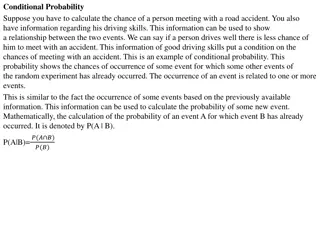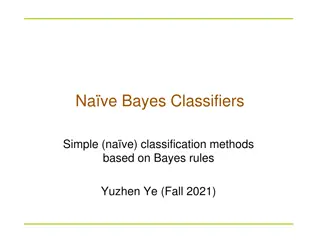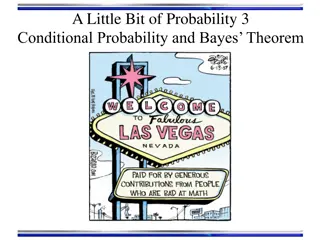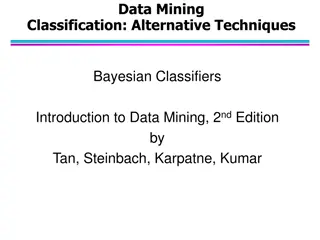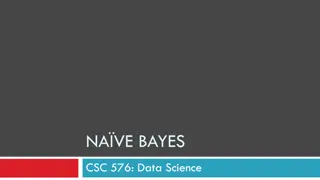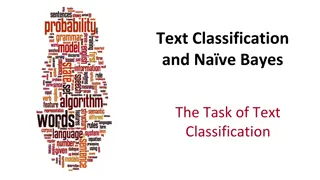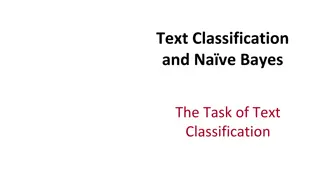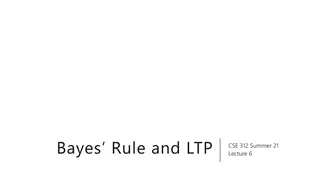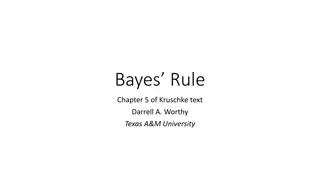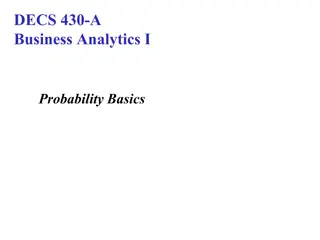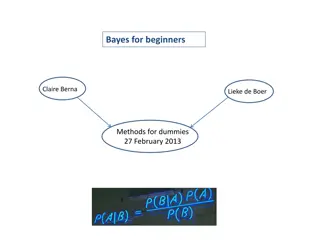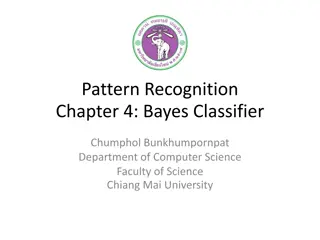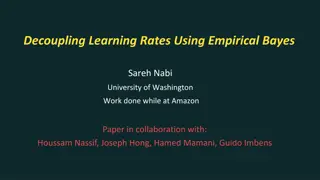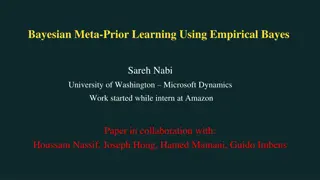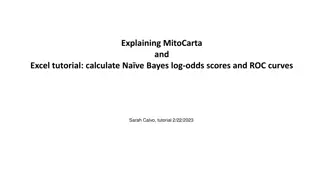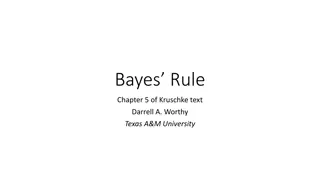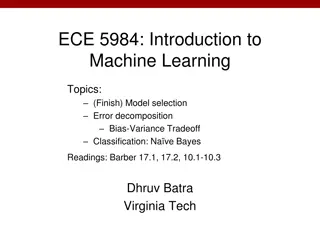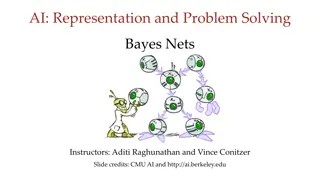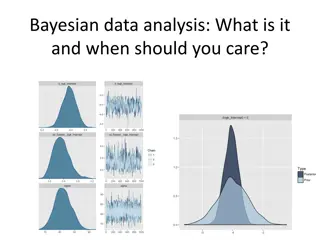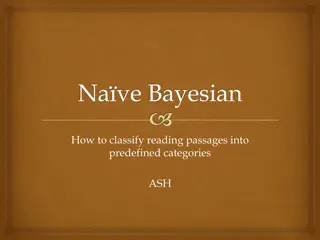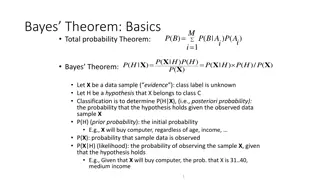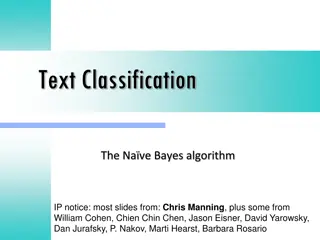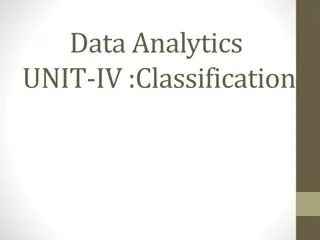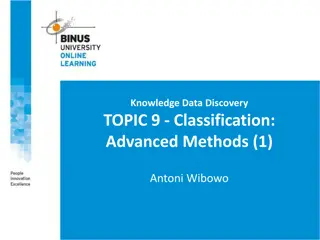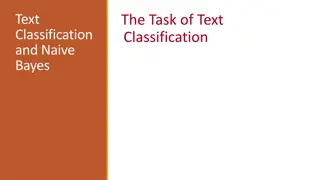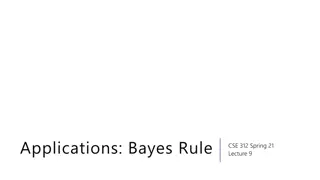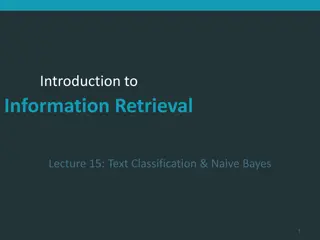Conditional Probability and Bayes Theorem
Conditional probability relates the likelihood of an event to the occurrence of another event. Theorems such as the Multiplication Theorem and Bayes Theorem provide a framework to calculate probabilities based on prior information. Conditional probability is used to analyze scenarios like the relati
1 views • 5 slides
Naive Bayes Classifiers and Bayes Theorem
Naive Bayes classifiers, based on Bayes' rules, are simple classification methods that make the naive assumption of attribute independence. Despite this assumption, Bayesian methods can still be effective. Bayes theorem is utilized for classification by combining prior knowledge with observed data,
1 views • 16 slides
Conditional Probability and Bayes Theorem
Conditional probability explores the likelihood of event A given event B, while Bayes Theorem provides a method to update the probability estimate of an event based on new information. Statistical concepts such as the multiplication rule, statistical independence, and the law of total probability ar
0 views • 15 slides
Introduction to Bayesian Classifiers in Data Mining
Bayesian classifiers are a key technique in data mining for solving classification problems using probabilistic frameworks. This involves understanding conditional probability, Bayes' theorem, and applying these concepts to make predictions based on given data. The process involves estimating poster
0 views • 20 slides
Naive Bayes Classifier in Data Science
Naive Bayes classifier is a probabilistic framework used in data science for classification problems. It leverages Bayes' Theorem to model probabilistic relationships between attributes and class variables. The classifier is particularly useful in scenarios where the relationship between attributes
1 views • 28 slides
Text Classification and Naive Bayes in Action
In this content, Dan Jurafsky discusses various aspects of text classification and the application of Naive Bayes method. The tasks include spam detection, authorship identification, sentiment analysis, and more. Classification methods like hand-coded rules and supervised machine learning are explor
1 views • 82 slides
Text Classification Using Naive Bayes & Federalist Papers Authorship
Dive into the world of text classification, from spam detection to authorship identification, with a focus on Naive Bayes algorithm. Explore how Mosteller and Wallace used Bayesian methods to determine the authors of the Federalist Papers. Discover the gender and sentiment analysis aspects of text c
1 views • 71 slides
Bayes Theorem in NLP: Examples and Applications
Introduction to Bayes Theorem in Natural Language Processing (NLP) with detailed examples and applications. Explains how Bayes Theorem is used to calculate probabilities in diagnostic tests and to analyze various scenarios such as disease prediction and feature identification. Covers the concept of
0 views • 13 slides
Bayes Rule and Conditional Probability
Dive into the concept of Bayes Rule and conditional probability through a practical example involving Wonka Bars and a precise scale. Explore how conditional probabilities play a crucial role in determining the likelihood of certain events. Gain insights on reversing conditioning and applying Bayes
0 views • 35 slides
Solving the Golden Ticket Probability Puzzle with Bayes' Rule
In this scenario, Willy Wonka has hidden golden tickets in his Wonka Bars. With the help of a precise scale that alerts accurately based on whether a bar has a golden ticket or not, we calculate the probability of having a golden ticket when the scale signals a positive result. By applying condition
0 views • 33 slides
Bayes Rule and Its Historical Significance
Bayes Rule, a fundamental theorem in statistics, helps in updating probabilities based on new information. This rule involves reallocating credibility between possible states given prior knowledge and new data. The theorem was posthumously published by Thomas Bayes and has had a profound impact on s
0 views • 34 slides
Approximate Inference in Bayes Nets: Random vs. Rejection Sampling
Approximate inference methods in Bayes nets, such as random and rejection sampling, utilize Monte Carlo algorithms for stochastic sampling to estimate complex probabilities. Random sampling involves sampling in topological order, while rejection sampling generates samples from hard-to-sample distrib
0 views • 9 slides
Probability Basics and Problem Solving in Business Analytics I
Understanding the basic rules and principles of probability in business analytics, including conditional probability and Bayes Rule. Learn how to solve problems involving uncertainty by decomposition or simulation. Explore how beliefs can be updated using Bayes Rule with practical scenarios like ide
0 views • 13 slides
Linear Classifiers and Naive Bayes Models in Text Classification
This informative content covers the concepts of linear classifiers and Naive Bayes models in text classification. It discusses obtaining parameter values, indexing in Bag-of-Words, different algorithms, feature representations, and parameter learning methods in detail.
0 views • 38 slides
Introduction to Bayes' Rule: Understanding Probabilistic Inference
An overview of Bayes' rule, a fundamental concept in probabilistic inference, is presented in this text. It explains how to calculate conditional probabilities, likelihoods, priors, and posterior probabilities using Bayes' rule through examples like determining the likelihood of rain based on a wet
1 views • 21 slides
Bayes Classifier in Pattern Recognition
Bayes Classifier is a simple probabilistic classifier that minimizes error probability by utilizing prior and posterior probabilities. It assigns class labels based on maximum posterior probability, making it an optimal tool for classification tasks. This chapter covers the Bayes Theorem, classifica
0 views • 24 slides
Decoupling Learning Rates Using Empirical Bayes: Optimization Strategy
Decoupling learning rates through an Empirical Bayes approach to optimize model convergence: prioritizing first-order features over second-order features improves convergence speed and efficiency. A detailed study on the impact of observation rates on different feature orders and the benefits of seq
0 views • 25 slides
Bayesian Meta-Prior Learning Using Empirical Bayes: A Framework for Sequential Decision Making Under Uncertainty
Explore the innovative framework proposed by Sareh Nabi at the University of Washington for Bayesian meta-prior learning using empirical Bayes. The framework aims to optimize ad layout and classification problems efficiently by decoupling learning rates of model parameters. Learn about the Multi-Arm
0 views • 27 slides
MitoCarta and Naive Bayes Integration in Excel Tutorial
Explore the process of calculating Naive Bayes log-odds scores and ROC curves in Excel using the MitoCarta dataset. Discover the best experimental techniques for isolating mitochondria in Arabidopsis studies, comparing methods like differential centrifugation and affinity purification.
0 views • 31 slides
Bayes’ Rule
Bayes Rule, a fundamental concept in statistics, explores how prior beliefs are updated based on new evidence. This rule, named after Thomas Bayes, has had a profound impact on statistical inference and has been further developed by mathematicians like Laplace. Exploring the probabilistic reasoning
0 views • 34 slides
Introduction to Machine Learning: Model Selection and Error Decomposition
This course covers topics such as model selection, error decomposition, bias-variance tradeoff, and classification using Naive Bayes. Students are required to implement linear regression, Naive Bayes, and logistic regression for homework. Important administrative information about deadlines, mid-ter
0 views • 42 slides
AI: Representation and Problem Solving
This comprehensive course covers topics such as Classical Planning, Propositional Logic, Markov Decision Processes (MDPs), Reinforcement Learning (RL), Bayes Nets, and more. Mid-terms, homework deadlines, and key concepts are highlighted. Explore Bayes nets and delve into Omega Pizzeria probability
0 views • 51 slides
Bayesian data analysis: What is it and when should you care?
Learn about Bayesian data analysis, Bayes theorem, Bayesian statistics, Bayes factor, and how Bayesians influence current data analysis. Understand the importance of integrating prior probabilities with new evidence to calculate posterior probabilities.
0 views • 30 slides
Bayes Models and Naive Bayes Algorithm Overview
Delve into the principles of Artificial Intelligence with a study of Bayes models and the Naive Bayes algorithm. Understand the concepts of full joint distribution, conditional independence, and inference in Bayesian networks. Explore applications in text classification and learn about calculating p
0 views • 15 slides
Classifying Reading Passages into Categories with Naive Bayesian
Text classification involves assigning reading passages to predefined categories for purposes like spam detection, authorship identification, and sentiment analysis. This process includes document pre-processing, feature indexing, applying classification algorithms, and performance measurement. Pre-
0 views • 35 slides
Fundamentals of Bayes Theorem and Classification
Bayes Theorem is a powerful tool for probabilistic reasoning and classification tasks. It involves deriving posterior probabilities based on prior knowledge and observed data. This technique is essential in making predictions and maximizing the accuracy of classification models. Nave Bayes Classifie
0 views • 15 slides
Bayes Classifier for Classification Modeling
Delve into the key idea of the Bayes Classifier by exploring its formulation based on Bayes Theorem. Learn how to calculate probabilities and frequencies to build a classification model using a simple dataset with features like Color, Type, and Origin. Uncover the process of converting frequencies t
0 views • 42 slides
Naive Bayes Assumptions and Rules
This content delves into the concept of Naive Bayes, discussing the assumptions made, zero counting, and basic rules such as the Product Rule, Sum Rule, and Normalisation Rule. It also provides examples and explanations on how to apply Bayes Rules for classification.
0 views • 20 slides
Automated vs Naive: Speech Emotion Classification
In this study, the performance comparison between an automated system and naive human coders in speech emotion classification is explored. Results suggest the feasibility of replacing naive human coders with automatic systems, with the automated system showing increased accuracy by only classifying
0 views • 20 slides
Introduction to Text Classification Using Naive Bayes Algorithm
Explore the world of text classification with the Naive Bayes algorithm. Understand its applications in identifying authors, determining sentiment in movie reviews, and more. Learn about the techniques used to categorize text and enhance your understanding of language processing.
1 views • 69 slides
Bayes Classifiers Exercises and Solutions
Dive into Bayes Classifiers through a series of exercises covering Bayes Theorem and its practical applications in various scenarios like population demographics, production defects in machines, and email classification. This comprehensive guide provides detailed explanations and solutions to help e
0 views • 17 slides
Prescribing Guidelines for Opioid-Naive Patients: MSSIC 2023 Performance Measures
Explore the importance of opioid prescribing guidelines for opioid-naive patients post-surgery. MSSIC aims to reduce opioid prescriptions at discharge by implementing collaborative-wide and site-specific performance measures, focusing on procedures like Lumbar Decompression and Anterior Cervical sur
1 views • 9 slides
Understanding Decision Trees and Naive Bayes in Classification Methods
Learn about the fundamentals of classification methods such as Decision Trees and Naive Bayes in data analytics. Explore how decision tree algorithms work, the concept of node depth, and the application of these methods in predicting customer behavior.
0 views • 35 slides
Advanced Methods in Classification: Bayesian Techniques and Theorems
Explore advanced classification methods like Bayes classifiers and Bayesian belief networks. Learn about Bayesian classification, Bayes theorem basics, prediction based on Bayes theorem, and more. Understand how these techniques help in probabilistic prediction and optimal decision making in data mi
0 views • 36 slides
Understanding Text Classification and Naive Bayes in Information Processing
Dive into the world of text classification and how Naive Bayes methods play a crucial role in tasks like spam detection, authorship identification, language identification, and sentiment analysis. Explore various methods like hand-coded rules and supervised machine learning for effective classificat
0 views • 82 slides
Understanding Bayes Rule in Real-World Applications
Explore the practical application of Bayes Rule in medical tests, helping doctors and patients understand health statistics. Learn how doctors improved accuracy using a simple calculation trick. Understand the significance of Bayes Rule in routine medical tests in the real world.
0 views • 24 slides
Bayesian Classifiers in Data Mining
Learn about Bayesian Classifiers and their application in data mining, including Nave Bayes Classifier, Bayes Theorem examples, and using Bayes Theorem for classification. Understand how to estimate probabilities and compute posterior probabilities for classification problems.
0 views • 16 slides
Text Classification & Naive Bayes for Information Retrieval
Explore the concept of text classification in information retrieval, focusing on techniques like Naive Bayes for tasks such as email spam filtering. Understand the formal definitions, training, and application aspects of text classification along with real-world examples of search engine classificat
0 views • 31 slides
Text Classification using Naive Bayes: A Comprehensive Overview
Dive into the world of text classification with this detailed exploration of Naive Bayes algorithm. Learn the formal definitions, applications, examples of classification in search engines, and challenges like sparseness. Discover the derivation of Naive Bayes rule and the importance of supervised l
0 views • 18 slides
Understanding Naive Bayes and Basic Probability Concepts
Explore the concepts of Naive Bayes, discriminative and generative models in supervised learning, probability principles such as total probability and Bayes theorem, and an example illustrating the application of Bayes theorem. Learn to estimate probabilities and apply the concepts into practical sc
0 views • 11 slides
